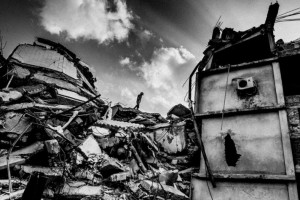Apr 24 2016 – Three years have elapsed since the collapse of Rana Plaza, Savar, on a fine morning of April 24, 2013. The disaster, one of the deadliest in the world s industrial history in two centuries, claimed the lives of 1,135 men and women and injured another 2,500, nearly 200 of whom severe enough to keep them hospitalised for months.

Photo: rahul-talukder
In the months following the accident, we, along with other colleagues, surveyed many such survivors with serious injuries. The victims were in the prime of their lives, their mean age being only 26. Two thirds were female and they were much younger than their male counterparts. Over 60 percent of the victims were married and 12 percent were either widows or divorcees.
Currently, we are following up with another survey, contacting as many as possible of those we had met in the summer of 2013. As may be apprehended, given the severity of the disaster, many survivors now face grave difficulties. It is encapsulated by Jorina s bitter comment : “I think it would have been better if they had cut off my legs. These legs are now the bane of my life. I am completely unable to walk and they are heavy. I can t move about as I wish to. All the time I have to use a wheelchair.” She comes from Naogaon, a northern district. There was nobody to look after her. “My daughter and son-in-law stay with me. I have two grand-daughters too, but there is not enough room for all of us to stay together in a one-room house. So I live on the verandah, I have to also sleep there.”
Soon after the collapse, the United Nations reviewed Dhaka s capacity for undertaking a major rescue operation and offered to help out. The Bangladesh Government expressed their confidence in managing the situation and refused their offer. A large number of deeply motivated but untrained volunteers played a key role in medical evacuation and rescue operations there. The Army, the fire service and other national agencies were also active part of these efforts.
Though the rescue operations continued for more than two weeks, almost three fourths of our respondents, fortunately, got rescued on the first day, namely on April 24, 2013. A good 10 percent were rescued on the second day and on the third day another 10 percent of our respondents were dragged out of the debris. According to our data, more than one-third of the victims were found unconscious on rescue. As many as 30 percent of the injured had fractures of one or more limbs.
Approximately 20 percent had spinal or head injury. One-fifth of the seriously injured required amputation of one or more limbs.
Hospitals and clinics in the neighbourhood proved the best; these institutions, coming out of everywhere, provided critical services to the survivors. Enam Medical College Hospital, Savar, has been the most common destination of the injured. Approximately half were directly taken to this non-governmental establishment. Less than 20 percent were taken to CMH (Combined Military Hospital) Savar, devoted exclusively to the armed services of the nation otherwise. After four weeks of the tragedy, we encountered many victims being transferred to CRP (Centre for Rehabilitation of the Paralysed), Savar, one of the best centres in Bangladesh for treatment of spinal injuries.
Approximately one fourth of the seriously injured suffered spinal injuries. Initial medical assessments diagnosed nearly half of these downright. However, only three were referred to CRP for initial treatment. Despite close reach and access to CRP, some complicated cases were sent to smaller hospitals where neither requisite skills nor logistics for advanced care of spinal fractures and other complications were handy. Spinal injuries, for instance, need immediate immobilisation for minimising neurological and other kinds of damage. In many cases that did not happen. The victims often had other injuries (like bleeding, soft tissue infections, fractured limb etc.) that could be handled in multi-disciplinary hospitals. Nevertheless, immediate mobilisation after the rescue could perhaps have prevented paralysis in some cases. Optimal emergency treatment requires effective triage (a process for quick assessment of the type or the urgency of medical problems) where many cases are brought in for treatment. It seems the triage at the site of Rana Plaza could have been better.
Immediate medical care was provided generously by hospitals, community organisations and people in general. This is less evident in terms of long-term care, however. Three years into the catastrophe, we encountered many victims in need of physical and occupational therapy. Others are experiencing post-trauma stress disorder and stand in need of psychiatric help. Many are not gainfully employed anymore. Most have returned to their native villages, taking with them the trauma and consequences of the catastrophe.
Among the survivors we recently met, was a woman, whose arm was amputated from her shoulder. While under treatment she became pregnant. Her baby is now less than three years old and it is very difficult for the mother to take care of her child with only one arm. Once, while taking the baby for vaccination, the baby fell and was injured. No one in the hospital had counselled her on the techniques of managing with one arm only. This case serves to illustrate the importance of addressing the long-term needs of survivors.
What is missing is a systematic initiative for their long-term rehabilitation and wellbeing. It s a shared responsibility no one can ignore. The garments industry, state health services, NGOs and, not least, civil society itself, can neither deny nor evade their call of duty.
The writers are members of a research collective directed by Prof. John Richards, School of Public Policy, Simon Fraser University, Canada.
This story was by The Daily Star, Bangladesh